Affiliate links on Android Authority may earn us a commission. Learn more.
Google Nexus 4 review! [video]
Published onDecember 5, 2012
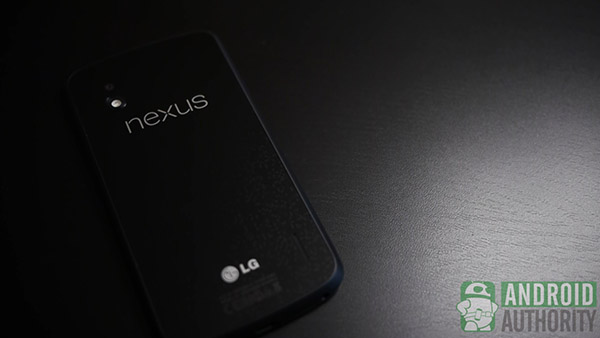
The Nexus One, Nexus S, Galaxy Nexus, and now, the Nexus 4. What a coincidence! Google’s newest official smartphone device is not only the fourth in its line, but sports a 4.7” screen. You have to love when things just seem to come together.
Jokes aside, it is really time to pay attention to Google and its newest offering in the Nexus line of devices for a couple of reasons: first off, the newest device brings with it the latest software, as this and the Nexus 10 tablet come with the most recent iteration of Android, Jelly Bean 4.2. And being a Nexus device means that this phone will be getting all the future updates first, before the rest of the Android bunch.
Secondly, this phone carries on its shoulders the weight of a phone manufacturer, with hopes of bringing it back from its unmemorable mid-tier game and back into the big leagues. Yes, Google has put its faith in LG, the Korean electronics giant whose recent phones have unfortunately drifted off into obscurity all too soon.
Perhaps luckily and definitely thankfully, LG might as well have included even the kitchen sink in their newest high-end phones, the Optimus G and the Nexus 4. If the Optimus G is any indication, Google bet on the right player.
Find out in this review if LG’s potentially greatest phone lives up to the Nexus name, and see my video review at the end.
Build and Feel
Let’s get the obvious out of the way before we even begin – if you think this phone looks familiar, you’d be right. The Google Nexus 4 looks so much like the Samsung Galaxy Nexus that one might accuse it of blatantly copying its predecessor. But the onset of the Nexus 4 and its familiar design likely hearken to a design template that Google is hoping to instill in its official line. I personally wouldn’t be surprised if we saw shades of the Galaxy Nexus throughout the next generation of the Nexus line, as well.
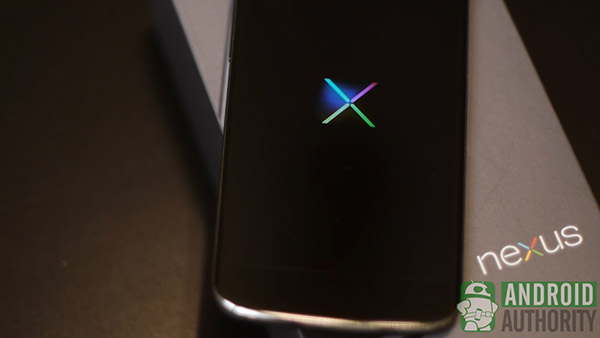
But it really isn’t a bad thing that the Galaxy Nexus seems to be echoed here – after all, its design was received well, and it translates well to LG’s own vision of the Nexus. Perhaps you will feel as I did in my comparison of the Nexus 4 to its fraternal twin, the LG Optimus G, when I found the familiarity of this phone actually added to its appeal.
The button layout is pretty standard, with the power button found on the right and the volume rockers found on the opposite side. Due to past experiences, I am quite paranoid that the power swtiches on any of my phones will eventually sink in and become unusable. While the one on the Nexus 4 doesn’t feel as meaty as the one found on my Galaxy Nexus, I think it is sturdy enough to stand constant presses.
Below the volume rockers is the microSIM slot, where SIM cards from your carrier of choice (GSM) will be inserted. An extra tool is provided with the phone to assist in reaching the release found in the tiny hold right beside it. At first usage, you will have to perform this minor surgery and correctly place the SIM card into the tray, after which it becomes a semi-permanent fixture of the phone. While having a small, slightly weird looking tool (or ‘poker’, as I called it once) might seem weird, it also makes sense – you don’t want people popping out your SIM card easily and crippling your phone.
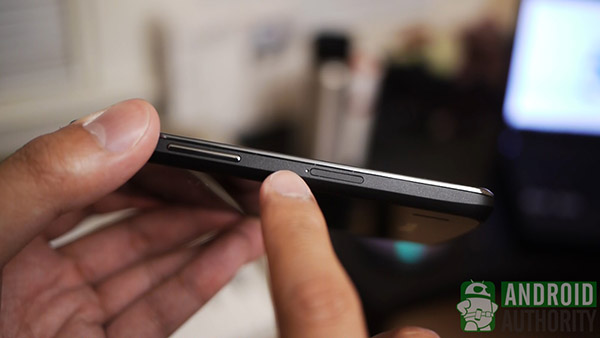
The headphone jack is found on the top of the phone, along with one microphone. The other microphone is found on the bottom, where the microUSB charging port is flanked by a seemingly new trope with LG phones – the Torx screws. As with the LG Optimus G, these Torx screws are actually an aesthetically pleasing addition, but they also mean that this phone is not supposed to be opened easily. This also means that the battery is not removable.
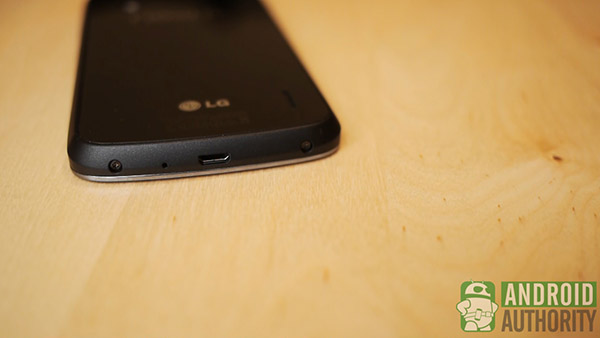
The back of the phone sports the eponymous ‘Nexus’ word across the upper half, while the 8 megapixel camera and coupled flash are directly above the ‘N.’ The entire back panel is protected by Corning Gorilla Glass, which is supposed to give it some good protection – unfortunately, a number of users have reported that even small drops can make either the back or the front render cracks pretty easily. So, be careful with this one.
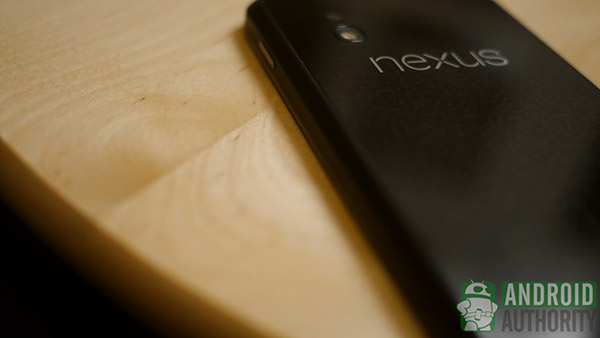
LG’s Crystal Reflection design brings back a nice aesthetic originally seen on the back of the Optimus G – at certain angles, a pattern of blocks can be seen. It serves as no more than eye candy but thus does its job quite well.
In the hand, the Google Nexus 4 further echoes its predecessor. At 139 grams, the phone is actually a tad heavier than most other devices, but you have to consciously think about it to feel the difference. Skin slides across the entire glass covered body, while the plastic and somewhat matted bezel connecting the two panels give the feel a little variety. Without a curved glass screen like the Galaxy Nexus, the Nexus 4 is a little thicker and thus has a bit of a blocker feel – which adds to its sturdiness in the hand.
There are certainly bigger phones out on the market, but the Nexus 4 manages to be big and balanced at the same time. I easily kept grip of the phone and was able to reach all parts of the screen without really having to fumble around to get there. All in all, this is a well designed phone by LG, and while it might look very much like the device that came before it, this is more a sign of things to come rather than a case of blatant design plagiarism.
Screen
LG put in its Google Nexus 4 the same True HD IPS screen that is found in the Optimus G, protected behind a layer of Corning Gorilla Glass 2. Between these two layers is, quite literally, nothing – this is due to LG’s Zerogap technology that does away with all layers usually found under the protective glass panel and above the actual display itself. LG claims that this technology not only enhances the display experience, but also helps make content ‘glide underneath the finger.’
At 1280 x 768 resolution and 320 pixels per inch density, you are certainly getting a good display out of this phone. Details shine through, crisp and clear, and even small text is easy to read. Videos are enjoyable to watch, as colors are all very well pronounced and vibrant. All of this beauty can also be attributed to the Adreno 320 graphics processor that helps bring your content through the Gorilla Glass. As it did in the Optimus G, all of these elements put together make for quite a viewing experience.
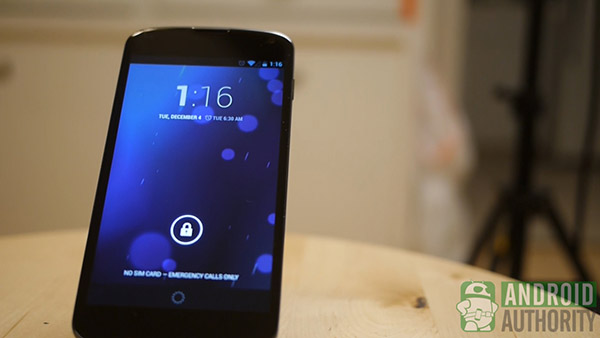
This is easily one of the best displays available on any phone, so LG should be commended for its offering on both of its top-tier devices. Viewing in broad daylight brings little to no trouble, as having the brightness at even around the 60% mark makes the display easily viewable. Angles are also all pretty much covered, as even in some precarious positions, the phone’s content is still in plain sight. I don’t imagine anyone trying to read stuff on this phone at an acute angle, but all this just provides more testaments to LG’s offering on the Nexus 4.
As far as touch responsiveness goes, especially considering the Zerogap technology, I personally was able to fly through menus, select content, and make Barry dodge and duck zappers in Jetpack Joyride with ease and speed. The claim by LG that Zerogap should make content ‘glide underneath your finger’ certainly seems to hold true here.
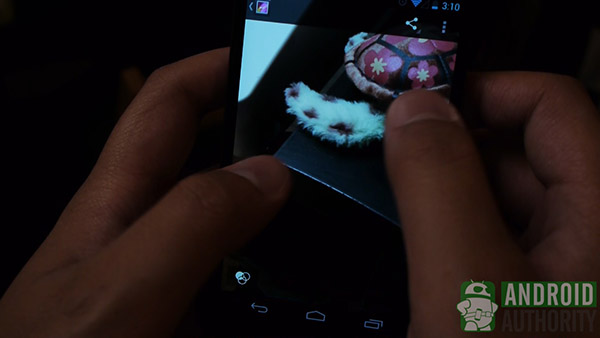
I do have to mention, as it was brought to my attention in the Nexus 4 vs Optimus G comparison, that some users have been experiencing touch issues with their new devices. In some cases, the screen would not register touches as immediately as one would expect from such a device, while another case involved multi-touch issues like the late response of pinch-to-zoom functionality in the Chrome web browser. I looked for myself and did find that the degree in which Android zooms content on the Nexus 4 (running 4.2) is less than experienced on my Samsung Galaxy Nexus (running 4.1.2). This held primarily true for Chrome, however, as I did not experience the same issue while viewing pictures in the gallery.
Issues with touch sensitivity are certainly problems that have to be mentioned and dealt with, but I believe that there might be more to it than just the screen or the Zerogap technology (which has been solely blamed at times). Comparisons with the pinch-to-zoom effects on the Galaxy Nexus have brought ideas that perhaps Chrome or even the new Jelly Bean OS are at fault. Many expect there will be an incremental update to Jelly Bean that addresses some of the lag issues seen beyond even just those experienced with the Nexus 4. Sometimes users simply tried a replacement device and found that their issues were resolved. Placebo effect or not, there is more to the issue than is easily discerned.
Investigations are ongoing, but the issues do not seem to be affecting everyone. On the flip side, I have heard just as many people state that while they might see a difference in multi-touch sensitivity, it ultimately comes down to an adjustment to be made by the user and is far from a deal-breaker. So, bottom line: I had a great time viewing and using the screen on the Nexus 4. It is one of the best displays available and you should be able to fly through the phone’s content with ease. You may or may not experience some of the sensitivity issues that some users have reported on, but remember that it can be due to more than just the possibility of having a dud.
Hardware
You’re getting some pretty incredible specifications on the Nexus 4 – LG was sparing no expense when creating this and the Optimus G. A quad-core Snapdragon S4 Pro processor bestows incredible power to this device, making the whole Jelly Bean experience snappy and almost seamless. The processor is backed by an already mentioned Adreno 320 GPU that really helps make the video and graphics look great behind the True IPS display.
It still boggles me how I can talk about a handheld device – much less, a phone – and be able to say that it has a quad-core processor. I remember when it was a big deal for a desktop computer to have that, and now the same power is in the palm of my hand. It also goes to show you how easily mobile devices can become out-of-date – the Samsung Galaxy Nexus remains as a very well-received and memorable phone, but that’s all it is at this point: a memory.
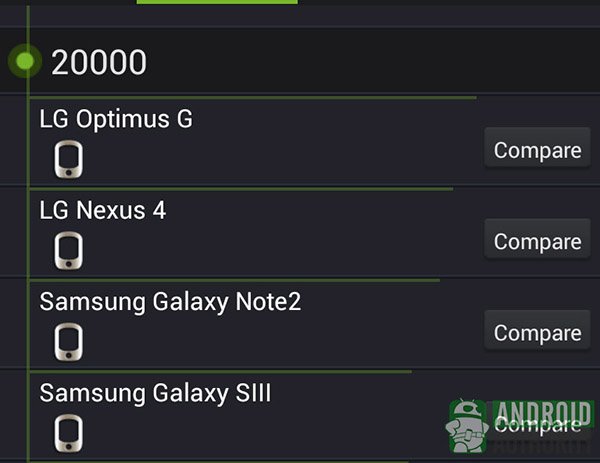
Benchmark tests put the Nexus 4 atop the device food chain, though admittedly just a smidgen below its fraternal twin, the LG Optimus G. This can happen for a number of reasons – also as mentioned before, some attribute lag in certain users’ general experiences to a lack of optimization in Jelly Bean 4.2. Whether or not this is the reason why the Nexus 4 (with the same guts as the Optimus G despite running a different version of Android) does not blow away the rest of the pack, remains to be seen.
You get 2GB of RAM for all the multitasking you want, and when your apps are being backed by such a powerful processor, you can pretty much have as much going on at the same time as you want. 8GB and 16GB internal memory options mean that there is no expandable memory capability – you’re stuck with what you got in there.
LG gets another notch on its belt for putting out one of the current greats in the smartphone market, and it just gets sweeter with Google’s backing of software updates and reasonable pricing. The Nexus 4 certainly seems like the real deal, and the on-paper hype most certainly translates well in practice. Apps load faster and smoother than ever while the new transition animations included in Jelly Bean 4.2 seamlessly bring some gorgeous eye candy to multitasking. All in all, this is one serious package stuffed in a pretty shell.
Battery
Battery life on the Nexus 4’s fraternal twin, as I reported in my .
” href=”https://www.androidauthority.com/lg-optimus-g-sprint-review-video-132826/”>review of the LG Optimus G, was more than adequate. I remember being able to get through full days of normal usage without much worry. The Nexus 4 comes with all the same guts of its non-Nexus counterpart, so the battery life should be around the same, right?
There have been some reports of poor battery life, though certain sources like Engadget have been able to update their reviews with news that more current replacement units brought better results. I believe I have one of these particular devices because I was able to get adequate battery life throughout a day’s usage. Using my borrowed microSIM card, I got from breakfast to bedtime (about 15 hours) without needing to plug in. When I did plug in the phone, the battery was down to the last few percent left, though I imagine different degrees of daily usage will make this situation vary.
I did do a battery drain test. Okay, so my dedicated battery life test with the Nexus 10 was a little too intense – streaming videos via WiFi and then streaming the resulting sound to my Bluetooth speaker at the same time (which brought the tablet’s battery to its knees at around 5 and a half hours). This time, I went with something a little more practical: a looping video playing while WiFi is connected to a network. This particular test drained the Nexus 4 down to about 5% just under the 7 hour mark. Having the HSPA+ running will likely bring this number down a bit, but such things are expected.
There is one thing you might miss about the Samsung Galaxy Nexus, in terms of its battery – the fact that it was replaceable. LG has fastened their Nexus device with those two Torx screws on the bottom that essentially seal the phone shut. The official word is that the battery, then, is irreplaceable – or at least tampering with it brings a lot of potential dangers, as we have reported. I remember the Galaxy Nexus coming with a cheap extra battery and charger/dock that felt like a steal when bundled with the plan and device. Having an extra battery is always handy when the phone is feeling power hungry; but with the Nexus 4, you’ll have to just bring along that charger for when the juice runs out.
Connectivity
So, here comes a hotly contested portion of the Nexus 4’s features – the connectivity. We will dive right into the main point everyone is talking about, which is the lack of 4G LTE. Yes, the Nexus 4 is capable of LTE and it is an option that can be enabled deeper within the settings, but it only works in particular areas like Canada. In the United States, however, there have been no reports that the publicized method of enabling LTE has worked – this is due to the Nexus 4’s connectivity being limited to certain bands of the 4G service. Without these bands enabled across the States’ LTE spectrums, it remains to be seen if people in the US will be able to take advantage of this seemingly uncovered capability.
That being said, the Nexus 4 is able to connect to 4G HSPA+ networks, which are not supposed to be as fast as LTE. Given that my model of the Google device was standalone and not from any carrier, I used someone else’s T-Mobile microSIM card to test out the call quality and mobile network on the phone. The phone did well in call reception, as the few calls I made to people were clear and there were close to no lapses in the feed.
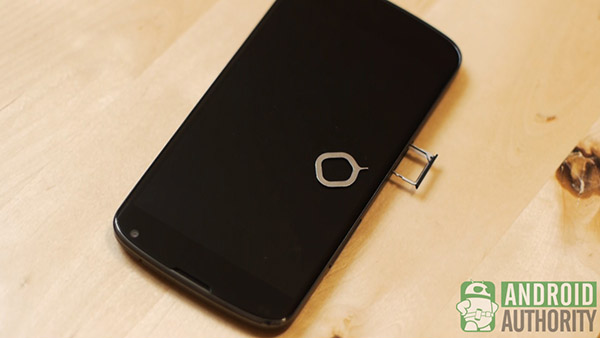
Which brings me to the question about mobile network speed. I have to admit that the difference in speed is noticeable – as a 4G LTE user on Verizon, I am used to some pretty breakneck speeds with my data, such as a HD YouTube video loading very quickly (it’s funny when my phone can load a YouTube clip faster that my laptop sometimes) or a Spotify song playing immediately.
In general tests, however, the Nexus 4’s HSPA+ is quite adequate – for most all tasks, the speed of downloading websites didn’t really bother me and I was able to enjoy viewing the internet with relative ease. Putting the T-Mobile HSPA+ side by side to my Verizon LTE showed that my Galaxy Nexus would load a webpage just before the Nexus 4. YouTube videos proved a little more of a challenge, however, as I would sometimes have to wait for even the low quality videos to load on the Nexus 4 – something I’m not often used to doing on my Galaxy Nexus.
I must mention that there was an interesting development in some instances my speed comparison test – when the Nexus 4’s HSPA+ would keep right up with my Galaxy Nexus’ LTE, I noticed differences in the reception strength. Given my location east of Los Angeles, my Verizon LTE had my Galaxy Nexus at half reception strength while the T-Mobile HSPA+ was running at full blast. This seems to have some bearing on the speed, as the Nexus 4’s full reception to the mobile network seemed to bring in some good results, though it was only really comparable to my Galaxy Nexus LTE going at half of its full capability.
So, while there are noticeable differences between HSPA+ and LTE, there isn’t a disastrous lack of speed on the Nexus 4. Those who are LTE loyal will have some gripes with the slowdown, but I believe the vast majority of people will see it as a small setback on an otherwise great phone and experience.
Other connectivity options include Near Field Communications. As this is a Nexus phone, one would hope that the capabilities of NFC Beam between such devices are backwards compatible. Luckily, I have a previous Nexus device, so I was keen to see. I did two tests, back and forth, using websites and pictures – both transferred seamlessly between the two devices. I figured it was worth a mention, because I have had trouble in the past doing Beams between my Galaxy Nexus and at least a Galaxy S3. It’s good to know that the Nexus line does retain continuity in this regard.
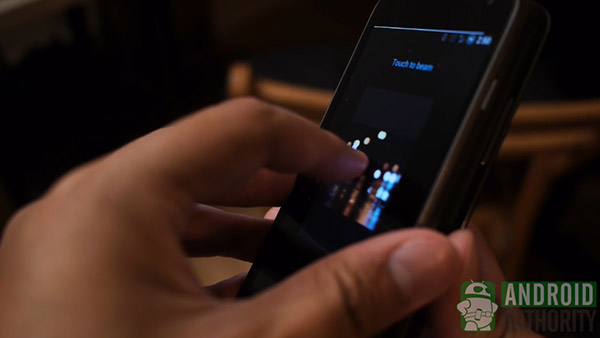
Newer features in the Nexus 4 include Miracast, a display streaming service that has become an official part of Android in version 4.2. I don’t have a Miracast-enabled television, so this is a part I cannot report on. This is the same deal regarding the Qi wireless charging ability – the Nexus 4 can handle this standard and Google has created a peripheral geared for wireless charging. I didn’t have any wireless charging mats or docks, but it has been reported to work as expected – I look forward to checking out the Orb soon.
Camera
The Google Nexus 4 comes with an 8 megapixel camera that performs decently well. It is certainly an improvement over its predecessor, which sported a 5 megapixel camera at below average quality – the only real claim to fame that the Galaxy Nexus had for its camera was the fast shutter. You could quite literally just keep pressing that shutter button and rack up a large number of shots.
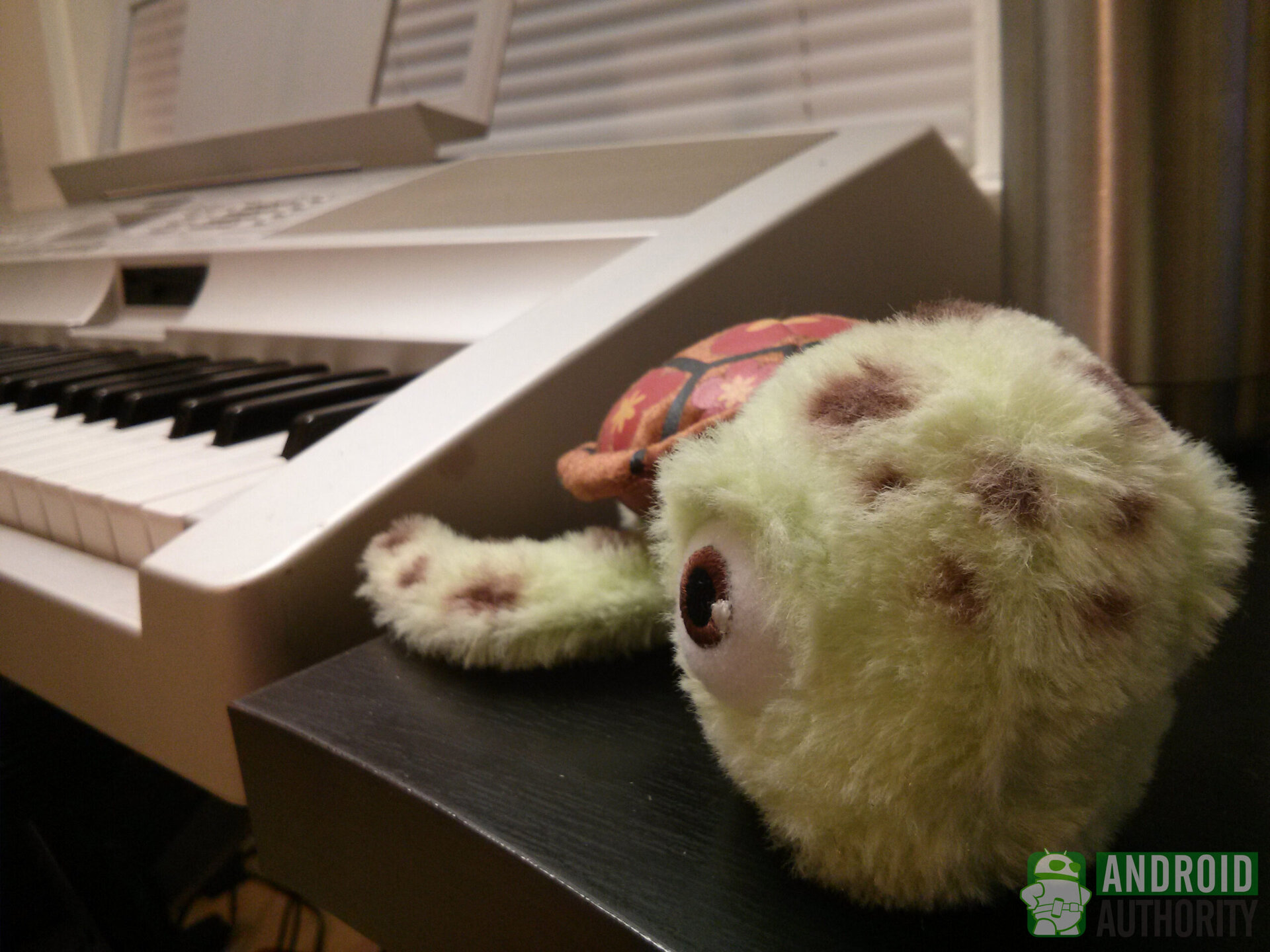
Photo quality on the Nexus 4 was actually quite good, as I found that the shutter speed used by the optics was adequate enough to get in enough light without blowing out the details the way the LG Optimus G did. From shutter to picture, the speed was not like that found in the Galaxy Nexus. It is still adequately fast, however, so users will just have to be aware of their photos and demand retakes when the shot goes blurry.
The flash, on the other hand, is quite powerful and can sometimes hurt the resulting photos instead of helping. It might be nice to throw some light into that dark indoor shot, but the sheer amount this flash puts out might blow out your content a little too much – not to mention your subject, who will be momentarily blinded.
Essentially, the interface and new features that Jelly Bean 4.2 brings to the table are the story here. A new camera app in the updated Android OS makes some changes to the way users take pictures while remaining somewhat familiar – your shutter button retains the blue color and look… and that’s about it. The interface has been quite overhauled, doing away with traditional touch and tap menus and opting for settings accessible by swipes. Simply touch and hold on any part of the viewfinder and swipe to the appropriate settings – the options will appear and then you just have to move your finger over to what you want and release. It is an elegant way of managing your camera that is very welcome and useful.
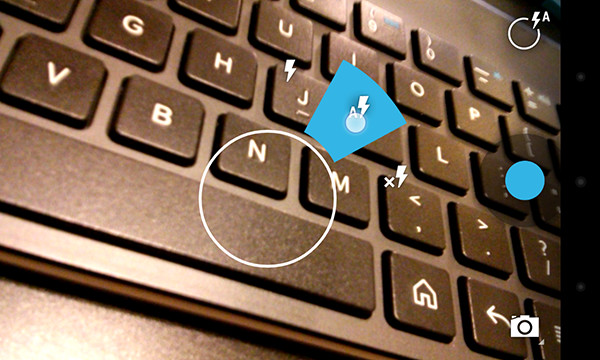
Aside from that, however, the options for picture taking are pretty standard, without really adding too much that we already know. HDR is available and helps you get a bit more punch out of the colors in your picture, while a small number of scene modes will help you get an effect you may want out of your content.
The main and pretty much only addition made to the general camera infrastructure is the inclusion of Photo Sphere. The much talked about feature allows for Street View-like pictures, as your phone uses the accelerometer to gauge positioning and you are guided around the grid with small blue dots that you center in the viewfinder. The captured shots are then all put together and a resulting 360 degree view of your surroundings is created. It is a very novel feature that I am sure many will find fun to use – I personally just don’t have much use for it.
Software
All this talk about the camera app brings me to one of the main stories of the Nexus 4, its included version of the Android operating system. As a Nexus device, this phone will receive all of the future updates from Google before everyone else. To a lot of people, this is a very big deal, and rightfully so – new features mean new experiences.
Jelly Bean 4.2 certainly lives up to that idea, as enhancements to the already tried and true Ice Cream Sandwich interface make the overall experience of Android more useful and enjoyable. For example, the new notification drop down menu has been added to, with a side of it now dedicated to the most used settings. After pulling down, a button on the right corner will rotate the notices and reveal tiles of various settings like WiFi and GPS. You can also reveal just the settings by doing a two-finger pull down.
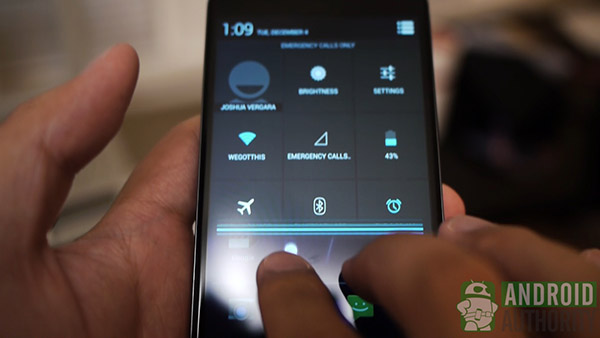
This is a very welcome addition to the stock Android OS, as power widgets and apps embedded in the notification drop down were previous ways that users could change their device’s settings. Now, Google has recognized that need and has baked those capabilities in.
The lockscreen has also been enhanced to include features previously only found on custom ROMs or installed replacements – now, on the lockscreen, swiping left and right from the edges of the screen brings widgets to the front. The lockscreen clock is an included widget, as is a camera launcher that is seen below. There are also widgets for calendar entries, e-mails, and messaging. This makes your most important information easily accessible without having to swipe the lock and go through your applications.
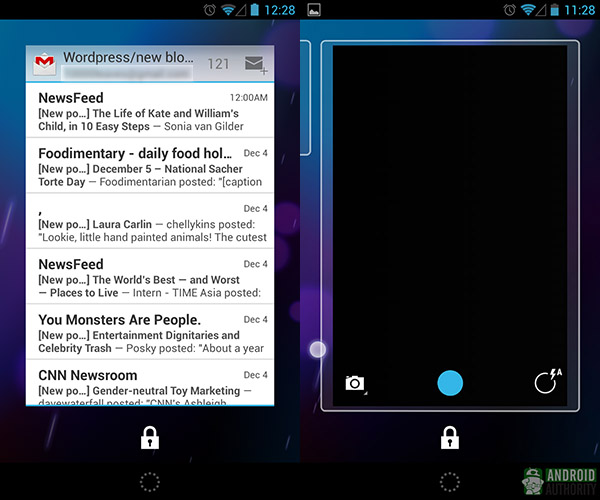
A new keyboard has been included with Jelly Bean 4.2, as well – actually, it is the same touch typing keyboard that we already know and love, but gesture typing has been added in. This is much like Swype, where you just have to swipe around the letters for the word you want. It works well enough, but is simply an added feature and might not keep you from installing a replacement keyboard anyway. I do have to admit that seeing the word you are swiping right above your finger is a nice touch and is very Google.
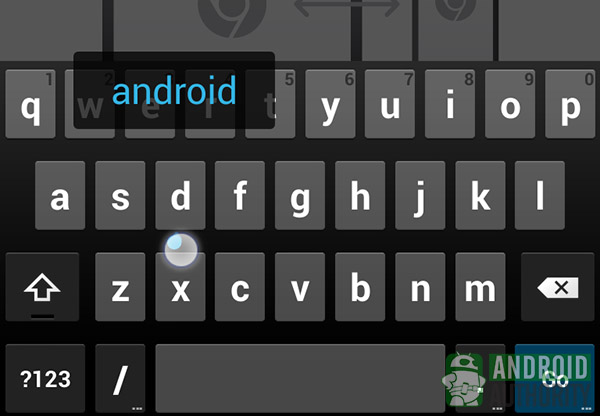
And of course, there is Google Now – the information and search hub has seen some updates in 4.2, with added cards that show you flight information (after digging in your GMail account for received confirmation notices) and even a birthday card that appears on, when else, your birthday. Voice search has been updated to receive more inquiries, and whole questions are now Googled if a specific function isn’t triggered. Other commands include opening apps (“open GMail”) and setting alarms (“set alarm for 7:30am, label, weekdays).
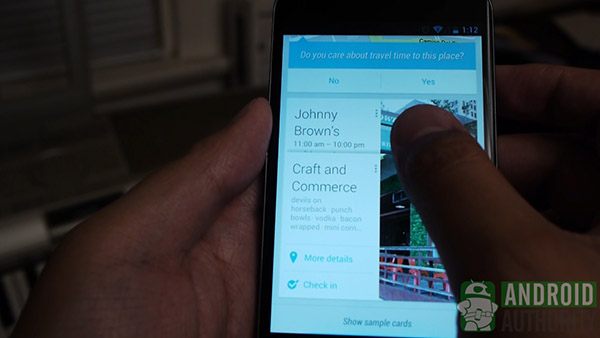
The last feature that would like to mention is the Daydream function. Smartphones can be more than just pieces of glass and plastic sitting on your dock or charging on your desk with black and blank screens. Google seems to have noticed this, as well, and they have included functionality that makes devices running 4.2 display pictures, colors, or even just the time after an elapsed time charging or docked. I actually really like this function, as it brings a little more usage from such a nice screen when I’m not using my phone.
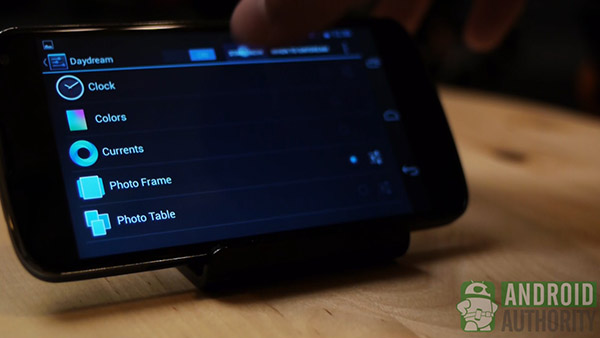
The clock is adequate enough, especially when the phone is functioning as a side table alarm clock; however, for when the phone is just docked nearby, you can use it as a photo frame. Imagine using this on the Nexus 10 sometimes. Just having the ability to use it when the desire arises is nice.
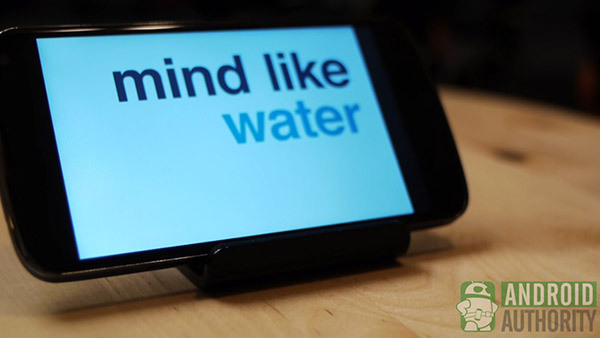
All in all, the newest version of Android is a pretty compelling reason to choose the Nexus 4. While the rest of the smartphone market tries to keep up, Google continuously brings out new versions of Android with new features that consistently feel like improvements on an already enjoyable and useful platform. With the Nexus 4, you’re already ahead of the game – for quite a few Android users out there, that’s one of the most important aspects of the Nexus line.
Conclusion
To answer the question of whether LG’s Nexus 4 lives up to its pedigree, one would have to look at the sum of its parts. It is already a feat to pack such high-end specs into this device, but the great translation into actual user experience is even more impressive. You’re getting top-notch Android in the Nexus 4 and that is a huge selling point right there.
As far as design goes, I have say that LG has improved on the previous Nexus offering by making a pretty smart move – taking what was already well-received and just building upon it. The Galaxy Nexus was already a fine looking device and the form factor was simplistic while retaining a sleek and inviting profile. In the hand, the Galaxy Nexus just fit and despite the large screen, discomfort was never a part of the experience. LG has taken all of this form and given it some shiny new front and back panels with some Crystal Reflection eye candy to top it off – and the result is an elegant phone that packs a lot of power.
And finally, the elegance and power helps bring Google’s vision of Android to life. The screen pops beautifully, making text easy on the eyes and graphics and video a treat to view. With updated, useful features that blend in with the already nice Android aesthetic, the update to Jelly Bean is worthwhile and enhances the Android experience. With the promise of first dibs on all future updates, it’s hard not to be happy with all that the Nexus 4 offers.
So, killer specs, a crisp and very pleasing display, a familiar aesthetic, and the latest and greatest software put the Nexus 4 just where Google wanted it to be – among the best. This device is available unlocked for $299 at 8GB and $349 at 16G – if you are looking to get one on contract, T-Mobile has the 16GB version at $199.
For all of the news and updates on the Nexus 4, keep it tuned here at Android Authority, your source for all things Android.